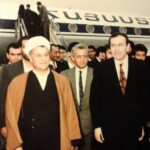The kaza of Bulanik, which bordered on the kaza of Melazkırt, had, with it 30 towns and villages and 25,053 Armenians, a very dense Armenian population on the eve of the war.
The mobilization of men between the ages of 20 and 45 took place without noteworthy incident here. As elsewhere, so here, the younger conscripts were assigned to combat units and the others were put in labor battalions that were used to effect military transports. These labor battalions, which traveled back and forth between Bulanik and Hinis, had a high mortality rate in winter 1914–15.
Furthermore, the requisitions in Bulanik, supervised by the kaymakam, Esat Bey, were so extensive that the area had suffered a severe grain shortage.
Thanks to the rapid advance of the Russian forces into the region in May 1915, the population of the villages in Upper Bulanik escaped massacre:the inhabitants of the principle town in the kaza, Gop (5,000 Armenians) fled to Melazkırt between 14 and 16 May when the Russians arrived there, as did those of the localities of
Yonjeli (pop. 1,560),
Kharaba Shehir (pop. 572),
Miribar (pop. 472),
Sheykh Yakub (pop. 1,200),
Plur (pop. 182),
Odnchur (pop. 1,295),
Teghud (pop. 1,168),
Latar (pop. 700),
Yegmal (20 households),
Kekerlu (pop. 1,306),
Khachlu (pop. 39),
Shirvan Sheykh (pop. 1,300), and
Maltlu (195 households).
The only exceptions were Karaghel and Hamza Sheykh. Hamza Sheykh, inhabited by 1,299 Armenians, was attacked by Kurds of the Jibran tribe and local Çerkez, who massacred its inhabitants on the spot, leaving only 14 people alive.
The villagers of Karaghel (pop. 1,312) fled along the banks of the eastern Euphrates (Murad Su), protected by 30 armed men led by Kevork Khlghatian, but were not immediately able to cross the river, which was in spate. Taking refuge on an island in the river, they fought off the assaults of Kurdish tribes for two weeks, and then succeeded in crossing to the other bank of the Euphrates, clinging to water skins that they had made with sheepskin.
The men of Gop opted to escort their women and children to the Russian lines when they learned that the Russian army was in Melazkırt; meanwhile, under the command of Gniaz Mkhitarian, Bedros Markarian, and Mushegh Seropian, the little town fought off Musa Kâzım’s assaults.
Some 100 Armenians lost their lives during the fi ghting, but the others later managed to flee. The villagers of the 11 localities in lower Bulanik, which lay much further to the southwest –
Liz (pop. 1,499),
Kerolan,
Abri (pop. 203),
Khoshkaldi (pop. 1,018),
Adghon (pop. 754),
Prkashen (pop. 517),
Goghag (pop. 472),
Akrag (pop. 267),
Mulakend (pop. 200), and
Pionk (pop. 457) – were less fortunate.
Khoshkaldi came under attack by Kurds commanded by Musa Kâsim Beg, the leader of the Jibran tribe, Haydar, and a well-known bandit, Jendi. The Kurds fi rst massacred the males over fi ve, and then turned to the women.
As for the members of the 60 households in Kerolan, they were massacred by Kurds under the command of local Kurdish sheikhs, with the exception of a few young women and girls who were carried off to Liz by their torturers.
Some of the villagers of Abri, Adghon, Prkashen, Goghag, Akrag and Mulakend were massacred in their villages around 10 May by Şeykh Hazret and Musa Kâsim.
The survivors, after trying in vain to cross the Turkish lines, fl ed to Liz, the principle town in the nahie, where the commander of the local garrison protected them until 18 May, the day Russian troops arrived in Upper Bulanik.
At that point, 1,200 men were put in chains and shot one verst (1,066km) from Liz; their bodies were dumped into two immense mass graves by regular troops.
It is, without a doubt, possible to see these massacres as connected with the operations carried out in the same period in the neighboring kaza of Akhlat (in the sancak of Bitlis), with a view to eliminating the Armenian population before the Russians arrived.
To be continued
Note- this chapter is from Raymond Kévorkian’s book ARMENIAN GENOCIDE: A Complete History.











